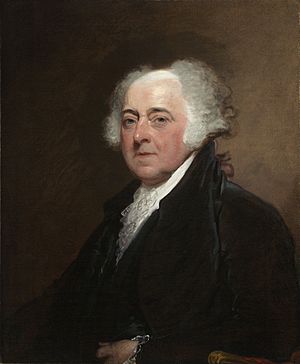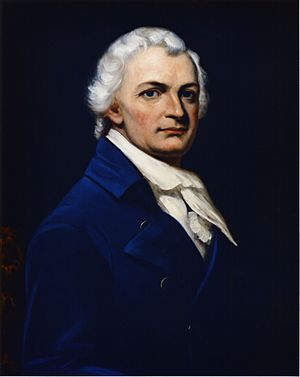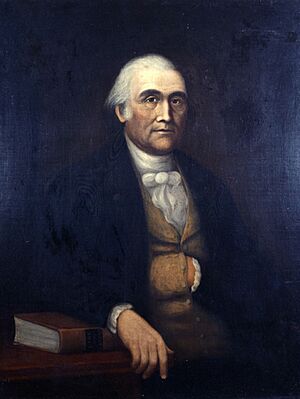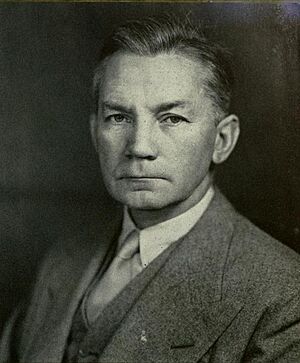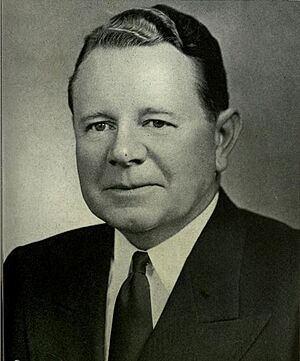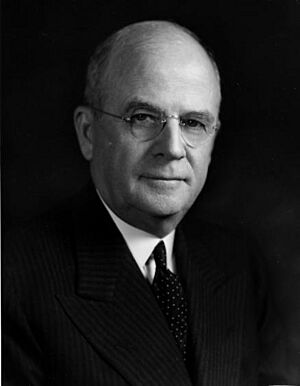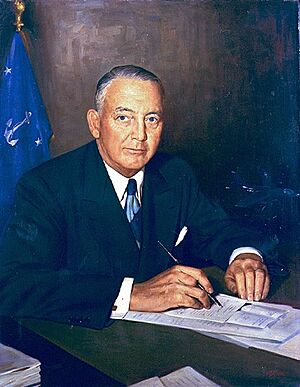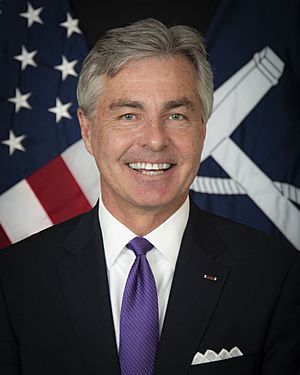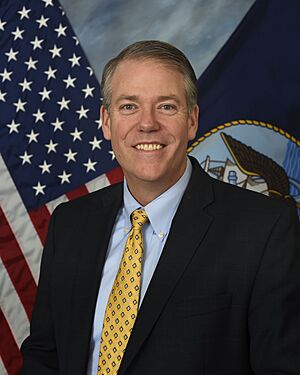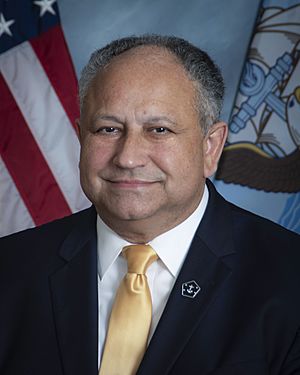United States Secretary of the Navy facts for kids
Quick facts for kids United States Secretary of the Navy |
|
|---|---|

Flag of the secretary
|
|
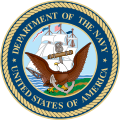
Seal of the Department of the Navy
|
|
| Department of the Navy | |
| Style | Mister Secretary The Honorable (formally) |
| Abbreviation | SECNAV |
| Reports to | Secretary of Defense Deputy Secretary of Defense |
| Appointer | The president
with Senate advice and consent
|
| Constituting instrument | 10 U.S.C. § 8013 |
| Formation | 18 June 1798 |
| First holder | Benjamin Stoddert |
| Succession | 3rd in SecDef succession |
| Deputy | Under Secretary (Principal Civilian Deputy) Chief of Naval Operations (Navy Advisor and Deputy) Commandant (Marine Corps Advisor and Deputy) |
| Salary | Executive Schedule, level II |
The Secretary of the Navy (often called SECNAV) is a very important leader in the Department of the Navy. This department is part of the United States Department of Defense. The Secretary of the Navy is like the chief executive officer for the Navy and the United States Marine Corps.
To become the Secretary of the Navy, a person must be a civilian. This means they cannot have been on active military duty for at least seven years. The President chooses the Secretary. Then, the Senate must approve the choice. As of March 25, 2025, John Phelan is the Secretary of the Navy.
Contents
The job of Secretary of the Navy started in 1798. For a long time, this person was a member of the President's top team, called the Cabinet.
However, in 1949, things changed. The Secretary of the Navy, along with the leaders of the Army and Air Force, began working under the Secretary of Defense. This made the Secretary of Defense the main leader for all military branches.
For many years, people in the United States Congress wanted to change the name of the Department of the Navy. They wanted it to be called the "Department of the Navy and Marine Corps." This would also change the Secretary's title. But this idea did not pass because a Senator named John McCain, who used to be in the Navy, was against it.
The Department of the Navy includes two main military groups: the United States Navy and the United States Marine Corps. The Secretary of the Navy is in charge of both. They have the power to "conduct all the affairs of the Department of the Navy." This means they lead everything, as long as it follows the law and the directions from the President and the Secretary of Defense.
Basically, almost all power within the Navy and Marine Corps comes from the Secretary of the Navy. They make sure everything runs smoothly.
Key Responsibilities
The Secretary of the Navy has many important jobs. These include:
- Finding and signing up new people (recruiting).
- Setting up how the Navy and Marine Corps are structured (organizing).
- Making sure they have all the supplies they need (supplying).
- Providing all the necessary gear and tools (equipping).
- Making sure service members are well-trained (training).
- Getting forces ready for action (mobilizing).
- Bringing forces back home after action (demobilizing).
The Secretary also watches over the building and fixing of naval ships, equipment, and bases. They create and carry out plans that match the country's security goals set by the President or the Secretary of Defense.
The Secretary of the Navy is also part of a group called the Defense Acquisition Board. This group helps decide what new equipment the military will buy. The Secretary also has duties related to military justice for the Navy and Marine Corps. This includes approving military court cases and changing sentences.
The two main military advisors to the Secretary of the Navy are the Chief of Naval Operations (CNO) for the Navy and the Commandant of the Marine Corps (CMC) for the Marines. These two leaders help the Secretary carry out their orders within their specific services.
The main rulebook for the Department of the Navy is called the United States Navy Regulations. Any changes to these rules must be approved by the Secretary of the Navy.
Role with the U.S. Coast Guard
Sometimes, the United States Coast Guard works as part of the Department of the Navy. When this happens, the Secretary of the Navy has the same powers over the Coast Guard as the Secretary of Homeland Security does when the Coast Guard is not part of the Navy.
The Secretary's Team
The Office of the Secretary of the Navy is the team that helps the Secretary do their job. This team is also known as the Navy Secretariat. Important people on this team include the Under Secretary of the Navy (who is the Secretary's main civilian helper), and several assistant secretaries.
This office is responsible for things like buying new equipment, checking finances, managing information, working with Congress, and handling public relations for the Navy.
Each year, the Secretary of the Navy and the Chief of Naval Operations recognize commands for their achievements. These awards are for things like protecting the environment, cleaning up pollution, saving natural resources, and preventing waste.
The Chief of Naval Operations and the Commandant of the Marine Corps have their own separate teams. These are called the Office of the Chief of Naval Operations (OPNAV) and Headquarters Marine Corps.
Denotes acting secretaries
Continental Congress Era
The very first leaders in charge of naval matters were part of the Continental Congress.
| Position | Portrait | Name | Term of office |
|---|---|---|---|
| Chairman of the Marine Committee | John Adams | October 13, 1775 – 1779 | |
| Agent of Marine | Robert Morris | August 29, 1781 – 1784 |
Executive Department (1798–1949)
This is when the official position of Secretary of the Navy was created. Denotes an Acting United States Secretary of the Navy
| No. | Portrait | Name | State | Start | End | President(s) | |
|---|---|---|---|---|---|---|---|
| 1 | Benjamin Stoddert | Maryland | June 18, 1798 | March 31, 1801 | John Adams (1797–1801) |
||
| 2 | Robert Smith | Maryland | July 27, 1801 | March 4, 1809 | Thomas Jefferson (1801–1809) |
||
| 48 | James Forrestal | New York | May 19, 1944 | September 17, 1947 | Harry S. Truman (1945–1953) |
||
| 49 | John Sullivan | New Hampshire | September 18, 1947 | May 24, 1949 | |||
| 50 | Francis P. Matthews | Nebraska | May 25, 1949 | August 10, 1949 | |||
Military Department (1949–Present)
Since 1949, the Secretary of the Navy has been part of the larger Department of Defense. Denotes an Acting United States Secretary of the Navy
| No. | Portrait | Name | Term of office | President(s) | |||
|---|---|---|---|---|---|---|---|
| Start | End | Duration | |||||
| 50 | Francis P. Matthews | August 10, 1949 | July 31, 1951 | 797 | Harry S. Truman (1945–1953) |
||
| 51 | Dan A. Kimball | July 31, 1951 | January 20, 1953 | 539 | |||
| 77 | Kenneth Braithwaite | May 29, 2020 | January 20, 2021 | 236 | Donald Trump (2017–2021) |
||
| Acting | Thomas Harker | January 20, 2021 | August 9, 2021 | 201 | Joe Biden (2021–2025) |
||
| 78 | Carlos Del Toro | August 9, 2021 | January 20, 2025 | 1260 | |||
| Acting | Terence Emmert | January 20, 2025 | March 25, 2025 | 64 | Donald Trump (2025–present) |
||
| 79 | John Phelan | March 25, 2025 | Incumbent | 276 | |||
See also
 In Spanish: Secretario de la Armada de los Estados Unidos para niños
In Spanish: Secretario de la Armada de los Estados Unidos para niños
- Military awards of the United States Department of the Navy
- Secretary of the Navy Council of Review Boards



